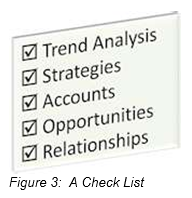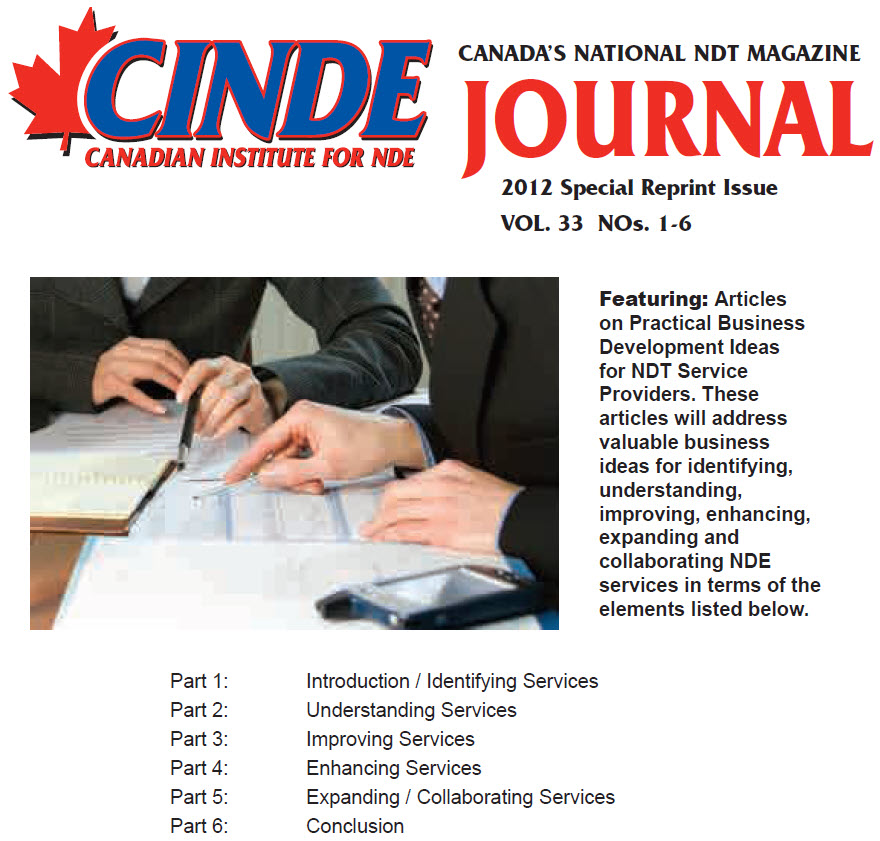Practical Business Development Ideas for NDE Service Providers – Part 3 of 6
Note: This article is the third in a series of six that appeared in the
Canadian Institute for NDE (CINDE) Journal throughout 2012. These articles address valuable business ideas for identifying, understanding, improving, enhancing, expanding, and collaborating NDE services in terms of the elements listed below.

- Introduction / Identifying Services
- Understanding Services
- Improving Services
- Enhancing Services
- Expanding / Collaborating Services
- Conclusion
Related: Effective Supplier Quality Surveillance (SQS).
The Third Element – Improving Services
The objectives of service improvement discussed here are two-fold. The first is to improve and maintain high quality services for all aspects of your business, from technical services and reporting, to cost-effectiveness and timeliness. The second is to develop a flagship client by becoming the client’s preferred or exclusive service provider.

The first improvement objective is reached by servicing the client’s wants and needs while continually providing high-quality services. Some ways to do that are:
- Developing and using checklists to ensure that all required information is referenced or obtained, used, and reported
- Paying attention to ensure all details required to complete the work are complete and correct (e.g., code, certification, technique, schedule, and any special requirements)
- Recognizing different service needs for the client as an owner or consultant vs. a manufacturer, fabricator, or constructor
- Reporting clearly and stating acceptance criteria using a full Code reference (e.g., for normal, category D or M fluid service, or severe cyclic conditions for ASME B31.3, and for static or cyclical loading for CSA W59)
- Stating clear references to any contract, purchase order, or project specification requirements (e.g., different or more stringent criteria in additional to Code requirements)
- Providing certified or qualified personnel and procedures according to client needs (e.g., ASTM, CGSB, CWB, NACE), or when certification is not required, clearly stating any other qualifications or performance demonstrations that are needed
- Completing report turnaround according to client needs (e.g., the same day on-site or as a draft, with a final copy on a defined timeline)
- Providing report formatting according to client needs (e.g., hand written, word processed with digital photos, peer reviewed, and data logged or any combination)
- Having positive, constructive interactions with all client or other personnel from the beginning to the end of a project. Managers, engineers, receptionists, secretaries, tradesmen, and supervisors all have a different job to do; your job is to help them so they will help you.
The second improvement objective is reached by identifying and establishing your client’s wants and needs, regardless of whether they are large or small; new or established requirements. Business development can mean continually adapting your services or educating clients about your services. Rather than simply relegating this to a sales and marketing department, business improvement activities should involve teamwork with contributions from appropriate people throughout the company.
In his article “Business Building – The Appreciation of Sales,”[1] Ken Pearce describes the difference between working in versus working on the business. He states that one main rule of business is that it is absolutely necessary to grow. He observes that circumstances such as times, technologies, and client requirements constantly change, so that if the clients are not calling you, you will need to call them. He also provides a list of ten tips for (new) sales personnel. CWA Engage will be publishing additional articles by Ken Pearce this year that promise to be equally as ‘engaging.’
The ultimate purpose of service improvement is sales improvement, but services don’t just sell themselves. Target clients must be identified, and business development efforts must connect with their wants and needs. This may be done in many ways, from advertising to cold calling, but at some point, the connection must be personal. In this day and age of overflowing email inboxes, texting and Twittering, it is too easy to forget the all import personal touch. When you’re developing client relationships, remember to pick up the phone to talk to clients or even better, visit and spend some time with them face-to-face. Voice mannerisms and body language together with what is said give more useful cues than just an email message.

And think about bringing someone else from the company with you too. Not everyone is a natural born salesperson, but technical personal have classroom-learned and field-tested competencies that are invaluable for helping explain the features and benefits of the many varied NDE techniques to your clients. Taking a team approach to a proposal meeting might impress customers with the talent and bench strength your company can bring to the table.
Also, some technicians may have or be able to learn sales skills easier than for a salesperson to acquire and communicate technical knowledge. Given that technical personnel often interact on a daily basis or during every job with client personnel, they are uniquely positioned as both a work force and sales and marketing force. A successful organization will have a team that connects with the client at all levels through an integrated sales and marketing approach. But still you may ask, “How can sales and marketing activities be incorporated into technical services?”
Using examples from two sectors, i.e. piloting aircraft and quality management, Mark W. Trimble states in his article “Checklists? You’ve got to be Kidding!” [2] that checklists serve two very useful purposes. First, he says that check lists are ‘what to do’ lists that provide a systematic and proven way of ensuring that tasks are completed. Second, he says that check lists are a ‘did I do it?’ list to confirm that all vital tasks have been completed. A good check list should include items that will ensure a client’s wants and needs are serviced today, but also include items that foster personal connections with the client by identifying new wants and needs for tomorrow. A great check list is constantly updated to reflect any new requirements for your clients and the work being performed. Tomorrow’s flagship clients can be developed by forging stronger personal connections with today’s target clients. No cold calling required.

In the first three parts of this series, best practice ideas have been shared and discussed for:
- Identifying, understanding and improving services for developing target, flagship, and problem clients.
- Using effective reporting, behavorial influence while establishing common ground.
- Working on instead of working in the business, and using check lists so that no important business practice details are forgotten.
In the next three parts of this series more ideas will be shared for enhancing, expanding and collaborating on client services. Some of these include attraction marketing, appreciative inquiry, and professional development, using online and offline resources that are at your fingertips.
Note
This article was originally published in the Canadian Institute for NDE (CINDE) Journal 2012 Vol. 33 No. 3 and in the CINDE Journal 2012 Special Reprint Issue Vol. 33 Nos. 1 – 6. http://www.cinde.ca/journal/
About the Author
Roy O. Christensen is a Welding Engineering Technologist who has over 35 years’ experience with O&G, pipeline, and other projects. He has authored countless instructions, manuals, plans, proposals, reports, specifications, and other documents that continue to drive success for many projects. He is the founder of the KT Project that saves organizations significant money and time, by providing key resources to leverage expert knowledge transfer for successful project execution.
Contact
- Roy O. Christensen
- [email protected]
- +1 403.703.2686
Figures
- Structural Steel Construction (not included in original article) http://www.rowecordgroup.com/user_resources/images/features/home/Image1.jpg
- Shaking Hands (different image than original article) https://d16yj43vx3i1f6.cloudfront.net/uploads/2020/06/GettyImages-1159039085.jpg
- A Check List http://www.territoryplan.com/wp-content/uploads/2011/10/Strategic-Plan-Checklist_early2.png
References
- Pearce, P., ”Business Building – The Appreciation of Sales”, CWA Engage Vol. 2 Issue. 1 January 2012 http://www.cwaconference.org/Engage/jan12.pdf
- Trimble, M. W., “Checklists? You’ve got to be Kidding!”, Modern Steel Construction July 2009 http://www.modernsteel.com/Uploads/Issues/July_2009/072009_checlist_web.pdf

